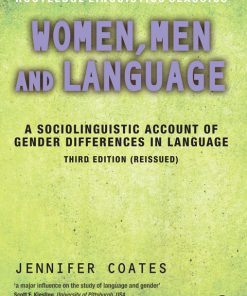Men Fathering and the Gender Trap Sweden and Poland Compared 1st Edition by Katarzyna Suwada 3319477824 9783319477824
$50.00 Original price was: $50.00.$25.00Current price is: $25.00.
Men, Fathering and the Gender Trap: Sweden and Poland Compared 1st Edition by Katarzyna Suwada – Ebook PDF Instant Download/DeliveryISBN: 3319477824, 9783319477824
Full download Men, Fathering and the Gender Trap: Sweden and Poland Compared 1st Edition after payment.

Product details:
ISBN-10 : 3319477824
ISBN-13 : 9783319477824
Author: Katarzyna Suwada
This book provides an account of fatherhood and changing parental roles in Sweden and Poland. It uses a comparative perspective to show what men understand a father’s role to be, and how they seek to live up to it. Fathering, the author argues, is a social phenomenon grounded in cultural patterns of parenting, gender roles and models of masculinity, and also shaped by family policy. Being a father today, she demonstrates, is longer connected solely with being the main breadwinner. Rather, it has become increasingly common for fathers to take on duties traditionally regarded as the domain of women. This means that men often face conflicting expectations based on different models of fatherhood. The aim of this thought-provoking book is to track these models, analysing their origins and their consequences for gender order. It will appeal to students and scholars of gender studies, the sociology of families and social policy studies.
Men, Fathering and the Gender Trap: Sweden and Poland Compared 1st Table of contents:
1: Introduction
Bibliography
2: Fatherhood and Change: An Overview
2.1 Fathers as a Subject of Sociological Reflection
2.1.1 Fathers, Traditional Parental Roles and Gender Equality
2.1.2 Fathers and Work–Life Balance
2.1.3 Fatherhood and Masculinity Models
2.2 Cultural Dimension of Fatherhood Definitions
2.2.1 Construction and Deconstruction of Gendered Parental Roles
2.2.2 Fatherhood Within the Institutional Context
2.3 “Involved Fatherhood”: Evolving Models of Male Parenting
2.3.1 How to Redefine Fatherhood?
2.3.2 Benefits of the New Model of Fatherhood
2.3.3 Hegemonic Masculinity, Caring Masculinities and Fatherhood
2.3.4 Motherhood and Fatherhood: Naturalism Versus Culturalism
2.4 Chapter Summary: Fatherhood and Social Change
Bibliography
3: Researching Fatherhood: Methodological Challenges
3.1 Introduction: Fatherhood Studies and Critical Studies on Men and Masculinities
3.2 Critically About Fathers and Parental Roles
3.3 Methodology of Fatherhood Research
3.3.1 Introduction: How Fatherhood Is Researched
3.3.2 Comparative Research on Fatherhood
3.3.3 Triangulation of Methods and Sampling Strategy
3.3.4 In-Depth Interviews—Characteristics of the Sample
3.4 Explanations and Limitations
3.4.1 My Starting Points
3.4.2 In-Depth Interviews—Why Middle Class?
3.4.3 In-Depth Interviews—Why Heterosexual Men in “Traditional” Families?
3.4.4 Challenges for the Qualitative Research
Bibliography
4: Fatherhood as a Political Issue: The Cases of Sweden and Poland
4.1 Fatherhood in Welfare State Regimes
4.1.1 Welfare States’ Typologies and Gender Order
4.1.2 Paid and Unpaid Work Within the Welfare State
4.2 Gender Equality and Politicising Parenthood—The History of the Swedish Family Policy
4.2.1 The Swedish Family Policy System Since 1930s
4.2.2 Fathers as Recipients of the Swedish Family Policy
4.2.3 Summary: Characteristics of the Swedish Family Policy System in 2013
4.3 Re-familialisation and Re-traditionalisation Processes—The Polish Family Policy Systems Aft
4.3.1 The Communist Legacy and Polish Family Policy
4.3.2 The Parental Leave Reform in 2013
4.3.3 Summary: Characteristics of the Polish Family Policy
4.4 Comparisons of Swedish and Polish Systems
4.5 Chapter Summary
Bibliography
5: “It’s My Responsibility …”: Definitions of Fatherhood
5.1 Introduction
5.2 Men as Breadwinners and Men as Involved Fathers
5.2.1 Breadwinning and Care Work
5.2.2 Division of Parental Leave
5.3 Fatherhood and Motherhood: Naturalisation of the Difference
5.3.1 The Reproduction of Gendered Individuals
5.3.2 Do Children Suffer When the Woman Has a Full-Time Job?
5.3.3 “Father Is Important for a Child Because He Is Tougher”
5.4 Fatherhood and Masculinity Models
5.4.1 “Suddenly They Became Real Men …”
5.4.2 Practice of Care and Reconstruction of Masculinity Models
5.5 Chapter Summary: Fatherhood, Change and Men’s Power
Bibliography
6: “I Can’t Really Work Less”: Fathers Facing Social Expectations
6.1 Introduction
6.2 Fathers Within the Welfare State System
6.2.1 Fatherhood: Cash or Care
6.2.2 The Relations Between Parents and the State
6.2.3 Parents’ Expectations About State Support
6.3 Fathers Facing Social Expectations
6.3.1 ‘I Would Be Careful with Grandmas …’
6.3.2 Models of Motherhood and Women’s Expectations
6.4 Men and Work–Life Balance
6.4.1 Paid and Unpaid Work
6.4.2 The Labour Market and Gender Wage Gap
6.4.3 How to Achieve Work–Life Balance?
6.5 Chapter Summary: Fathers’ Embedment in the Institutional Context
Bibliography
7: “I Had No Idea It Is So Hard”: Practices of Fatherhood
7.1 Introduction
7.2 Fathering, Paid Work and the Division of Domestic Obligations Within a Household: Some Sta
7.2.1 Men’s and Women’s Paid Work
7.2.2 The Division of Housework
7.3 Experience of Being a Father
7.3.1 Becoming a Father
7.3.2 How Fathers Become More Motherly
7.4 The Naturalised Differences in Parenting and Power
7.4.1 Fighting or Accepting Distinctive Parental Roles
7.4.2 Care Work and Domestic Duties: Power in a Household
7.5 Chapter Summary: Fatherhood and the Gender Order
Bibliography
8: Conclusions: Fathers, Gender and the Welfare State
8.1 Gendered Men and the Welfare State
8.2 Why Is the Change Needed?
8.3 How to Turn Men into Involved Fathers?
8.4 Further Research
People also search for Men, Fathering and the Gender Trap: Sweden and Poland Compared 1st:
the gender craze
how to tell the gender of a venus fly trap
gender trap meaning
the gender trap emily kane
the gender experts reviews
Tags: Men, Fathering, Gender Trap, Sweden, Poland Compared, Katarzyna Suwada
You may also like…
Uncategorized
History - European History
Cookbooks
Linguistics - Sociolinguistics
Politics & Philosophy - Social Sciences
Globalization and Sovereignty: Beyond the Territorial Trap John Agnew
Poetry - American Poetry












